Roman Amphorae: a digital resource
University of Southampton, 2005. (updated 2014) https://doi.org/10.5284/1028192. How to cite using this DOI
Data copyright © University of Southampton unless otherwise stated
This work is licensed under the ADS Terms of Use and Access.
Primary contact
Dr
David
Williams
Dept of Archaeology
University of Southampton
Avenue Campus
Highfield
Southampton
SO17 1BJ
England
Tel: 080 593032
Resource identifiers
- ADS Collection: 463
- DOI:https://doi.org/10.5284/1028192
- How to cite using this DOI
Ayla-Axum

Courtesy of Masawa Museum
Darren Glazier
Distinctive FeaturesA cigar shaped amphora, with small handles and a rim recessed for a lid. The body is strongly ribbed.See characteristics | ||
Date RangeEarliest date is at Berenike in the fourth century AD (Tomber, 2004); the latest date is the seventh century AD at Aqaba (Melkawi et al, 1994) and Adulis (Paribeni, 1907).Search: [4th century AD] [5th century AD] [6th century AD] [7th century AD] | ||
OriginThe only known kilns are at Ayla (Aqaba) in Jordan (Melkawi et al, 1994).Search: [Eastern Mediterranean] [Jordan] [The Levant] | ||
DistributionThis is characteristically a Red Sea and Indian Ocean type, with known finds at Adulis, Aksum, Abu Sh’ar, Aqaba, Berenike, Assarca, Matera, Burnu, Dese, Qana. Only example known is from the Mediterranean region at Bodrum (Alpözen et al, 1995)Search: [Eastern Mediterranean] [Egypt] [Eritrea] [Ethiopia] [Jordan] [North Africa] [Red Sea] [Western Asia Minor] | ||
ContentsUnknown.Search: [Unknown] | ||
CommentsPrincipal contributor: David Peacock |



 3D models
3D models


